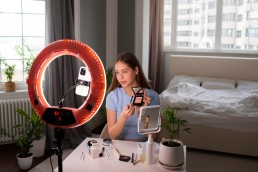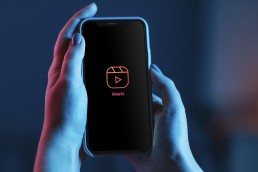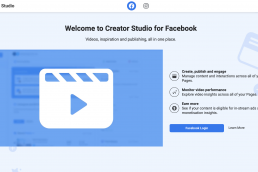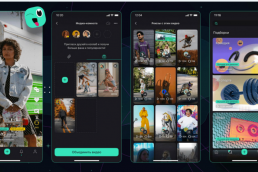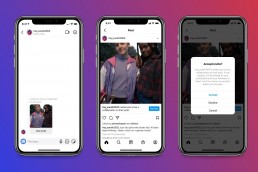As social media platforms evolve, businesses see TikTok’s marketing power. But, with the changing algorithm and rising competition, a good TikTok ad strategy is vital to maximise your ROI.
Moreover, this article will dive into TikTok advertising best practices. It will cover ad formats, Tiktok campaign optimisation, Tiktok marketing tips, and Tiktok ad targeting.

What are TikTok ads?
TikTok ads are a type of online ad. They let businesses promote their products on TikTok to a targeted audience. These ads can take various forms, such as:
- In-feed ads.
- TikTok video ads.
- Spark Ads.
- TikTok image ads.
- Shopping ads.
- Carousel ads.
- Playable ads.
- Pangle ads.
Managed Brand Ads
Brands that work with TikTok reps can access more ad options, such as:
- TopView Ads.
- Branded Hashtag Challenges.
- Branded Effects.
How much do TikTok ads cost?
Ah, the million-dollar question. TikTok paid ads vary based on several factors. These include your target audience, ad format, and campaign goals.

Here’s a general breakdown of what you might expect:
- Least Spend: TikTok requires around $50 per day for campaigns and around $20 for ad groups. However, prices can escalate based on competition and bidding strategies.
- CPC & CPM: The CPC is about $1. The CPM is about $10.
How to set up a TikTok ad campaign
TikTok Ads Manager is like Facebook Ads Manager. But it has fewer targeting options.
Thus, your video ads need to stand out to capture attention. Follow these steps to create an effective TikTok ad campaign.
Step 1: Create a TikTok ads account
[Note: Make sure you have a TikTok for Business account.]
Go to the TikTok for Business website. Then, navigate down and sign up with an email or phone number.
Read TikTok’s terms and privacy policy. If they are fine, click “Accept.” Then, click “Continue” to access TikTok Ads Manager.
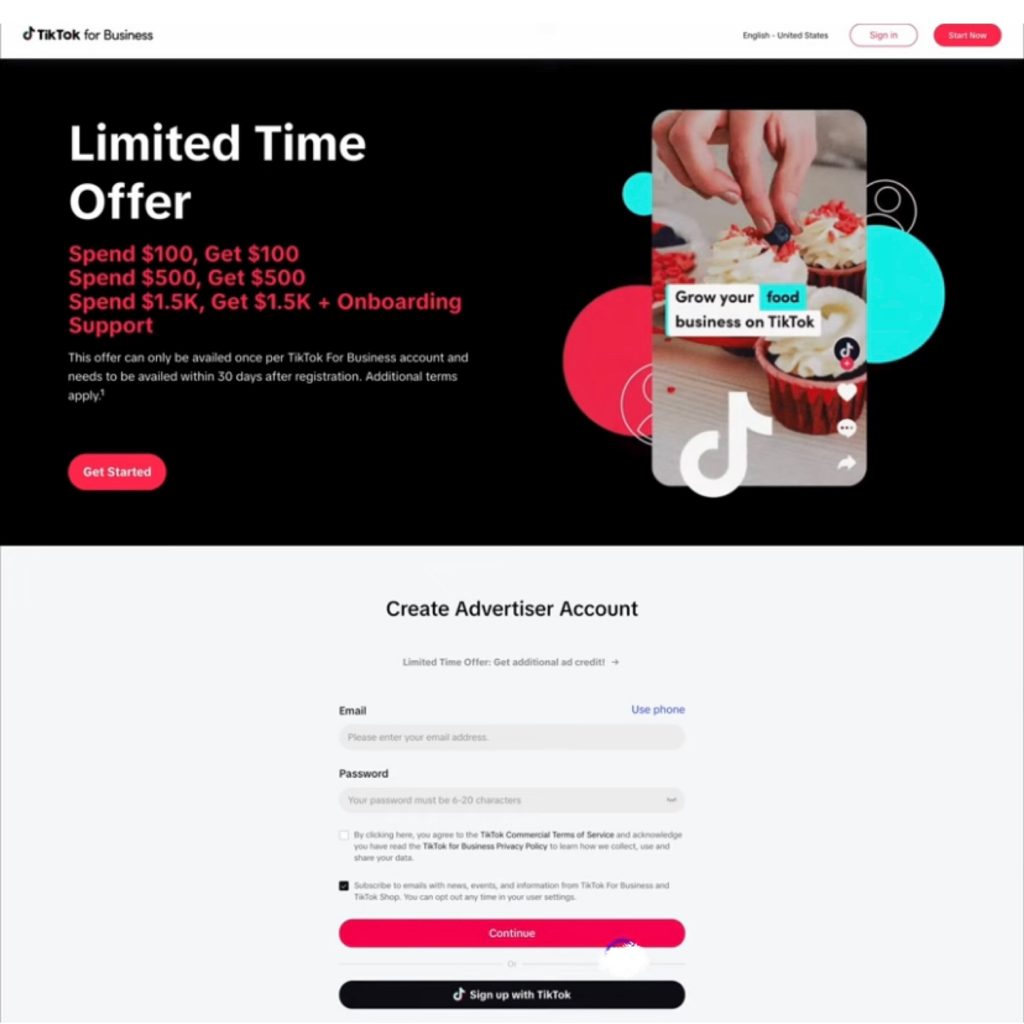
Step 2: Create and install your TikTok pixel
Log in to your Shopify account. While in your Shopify store, locate “Apps.” Then, search for the TikTok app (created by TikTok) and install it. Click on “Add sales channel.” Scroll down and click “Set Up Now.” Then, tap on “Connect TikTok for Business.” Make sure you have the correct TikTok account ID, then scroll down and tap “Connect.”

Under the TikTok Business Center account, tap on “connect.” Also, for your TikTok Ads Manager, click “connect.”.
Then, for data sharing, it’s best practice to tap on “enhanced” to begin with. When you’re done, click “create pixel” and hit “confirm.” Make sure you have the five green ticks. Then, click “Finish Setup.”
You’ll see a pending notification, but don’t panic. It just means it is being reviewed (usually within 24 hours). While you wait, install a Chrome extension called “TikTok Pixel Helper.” It will check the functionality of your pixel. Log in and click “Add to Chrome,” then tap “Add extension.”
Then, visit your Shopify site. Click the TikTok Pixel Event Helper. Verify it is tracking correctly, then return it to your TikTok Ads Manager.
Tap on “Tools,” then “Events,” and select “Manage Web Events.” After that, click on the pixel you connected to Shopify. There, you can track data from triggered events in your Shopify store.
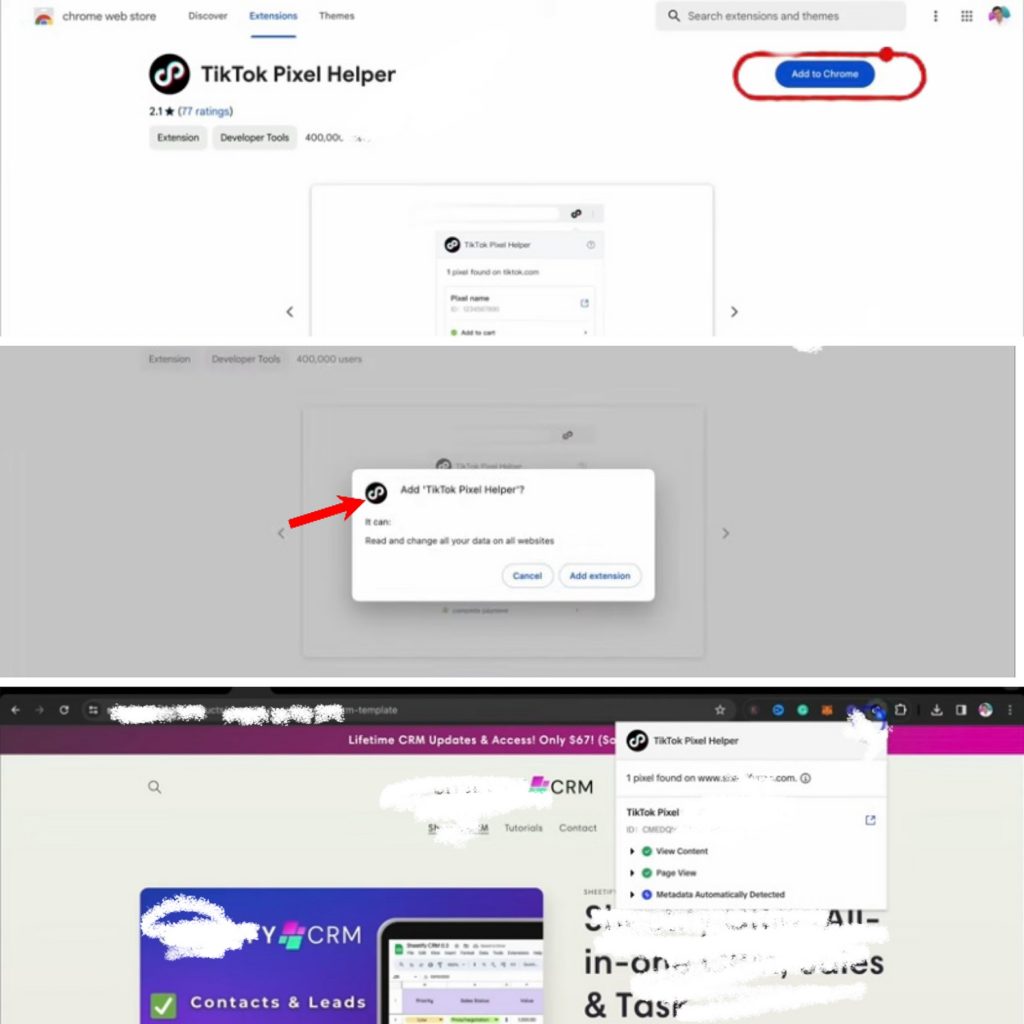
Once you have installed and linked your pixel to TikTok Ads Manager, you are ready for the next steps.
Step 3: Select your campaign aim and set up billing.
Now, in TikTok Ads Manager, click “Campaign” and “Create.” Choose “Custom Mode” for more control over your ads.
Select the advertising objective that fits your goals. Under campaign type, enable the “Smart Performance Campaign” for automated optimisations.
Under settings, you will change the name of your campaign. Then scroll down and turn on the “campaign budget optimisation”.
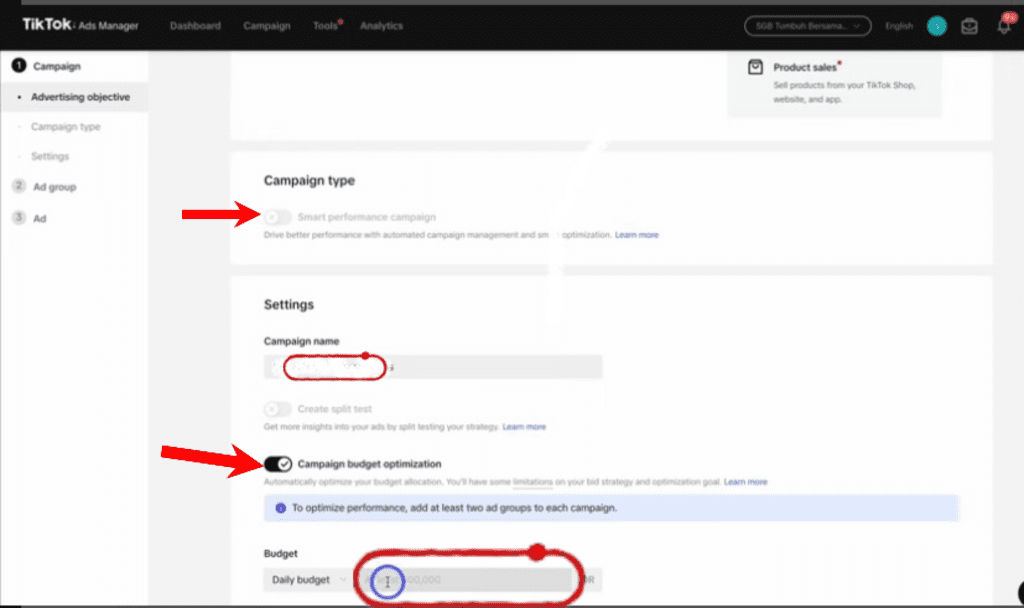
Then, you’ll set your budget. It is best to put your daily budget to £50. After that, click on continue.
Step 4: Set your target audience and schedule
[Note: This will take you to the ad group level.]
Add an ad group name. Then, scroll down to the optimisation location. Choose any one that suits your brand.
Then, select your TikTok pixel and choose the event you want to optimise. Go down to the optimisation event and click on “complete payment.” Set your placement options, ensuring your ad appears only on TikTok.
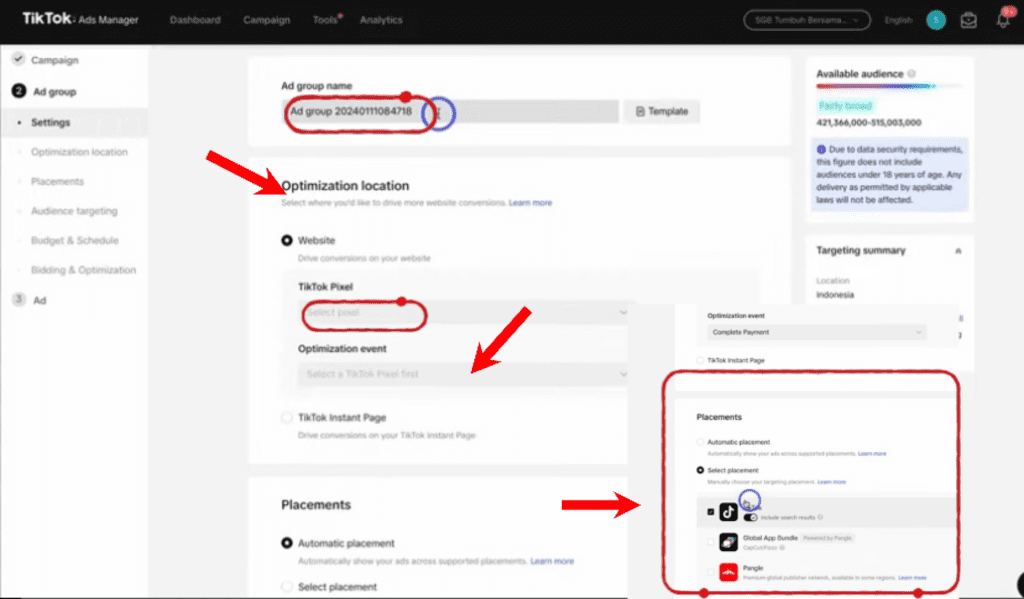
Navigate to audience targeting. Click on demographics. Select the countries, gender, language, age group, and spending power that match your preferences.
Then, navigate down to your audience. You can skip the include and exclude options. Focus on interests and behaviours. Choose an interest your audience might like.
Scroll down further and click on devices; make sure you leave the default settings as they are. When satisfied with your result, click “save new audience”. Give it a name, navigate down, and click on “save”.
Then, if you scroll down, you will see “budget & schedule.” Under this, click “schedule.” Set your time to add “ads continuously”.
[bonus tip: if it is your first time doing this ad, setting an end date is best. Try to put it for a week. For instance, if your selected date starts on 01-02-2024, set the end date to 07-02-2024.]
Under day-parting, if you like, you can choose “all day” or select a particular time. Then, navigate to bidding and optimisation; keep the default setting under this. Then click on “Next”.
Step 5: Create your ad content
This will take you to the smart creative ads. Scroll down to “Ad name”, and name your ad.
Then, navigate down and make sure your identity is correct; you can also create a custom identity if you like.
Go down to “ad details”, under “Ad creative”, tap on “video” and click “upload”.
This will take you to another gallery. Then, you’ll select the video you’ve already created, and after that, you navigate down and click on upload. TikTok will take some time to process your video before uploading it.
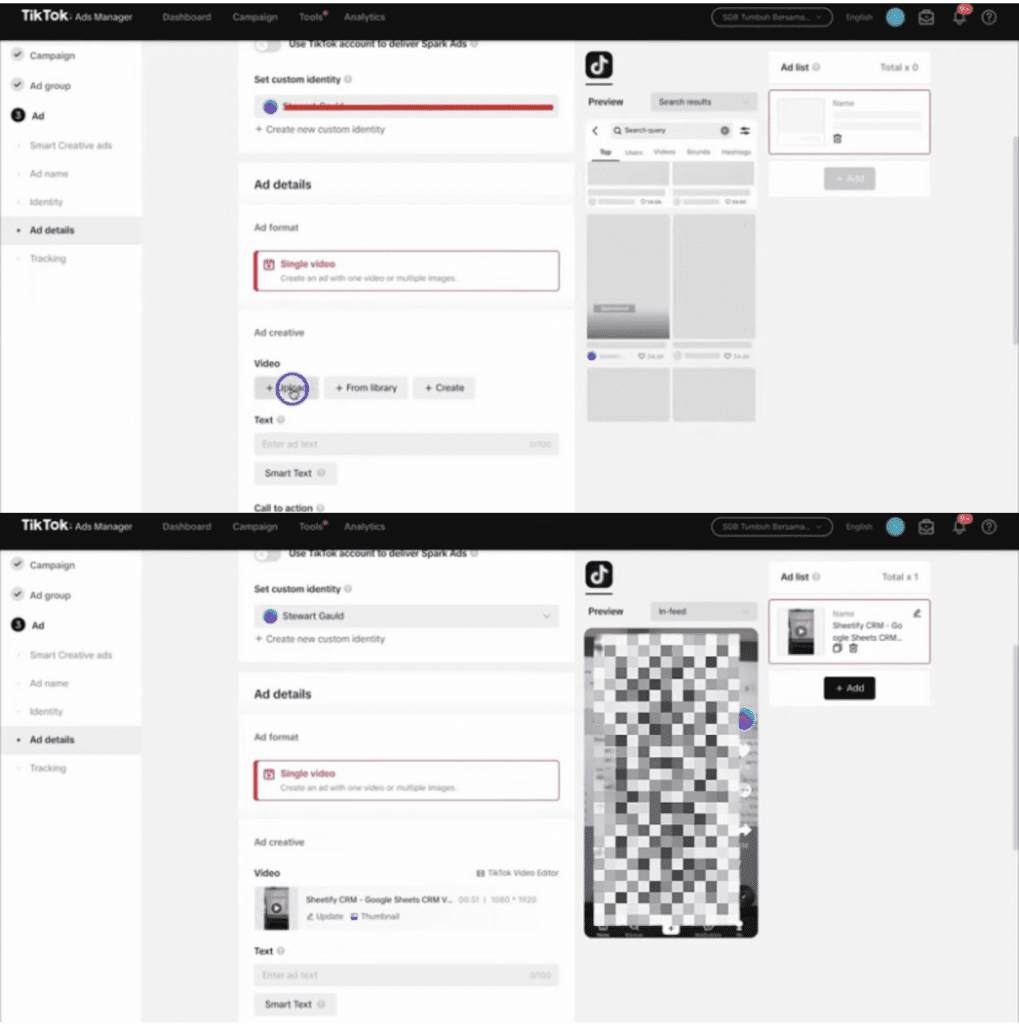
Once uploaded, use TikTok’s in-platform video editor for more adjustments if needed. Add a thumbnail if you want, but skipping it can make your ad blend in with regular content.
Keep your text brief and clear. Then, include the call-to-action, interactive add-on, and your website URL.
When navigating to tracking, ensure you add the TikTok pixel to your website events. And then leave the rest as it is.
Step 6: Submit and publish
Once your ads are ready, click “publish”. You’ll see a congratulatory message informing you that your ad is in review. Moreover, add your payment details if prompted.
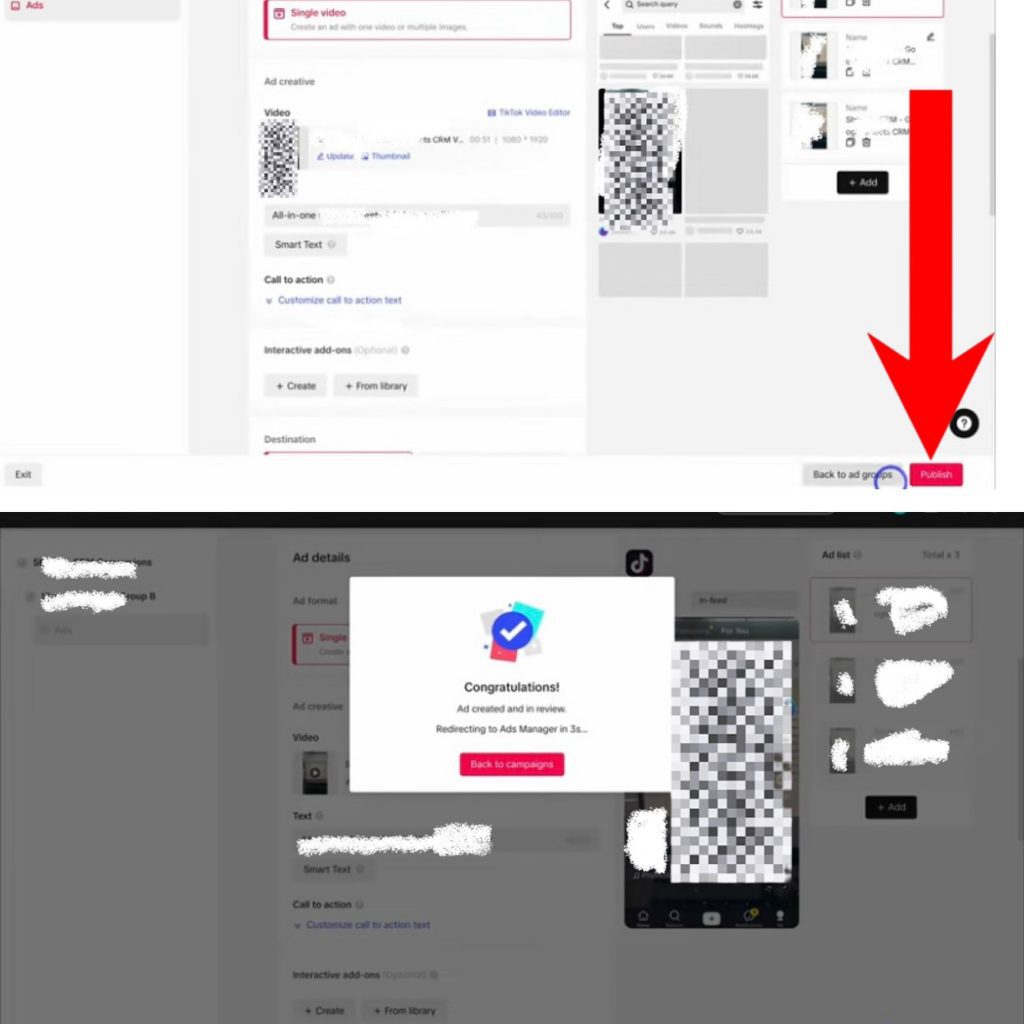
TikTok advertising best practices
To make your ads stand out, use these simple, effective TikTok advertising strategies.
Capture attention in a flash.
You have only three seconds to grab the attention of your audience. Make sure your ad is interesting and engaging from the very start.
Use TikTok’s specs.
Make sure your TikTok ad formats meet the app image and video specifications. This will ensure that your ad looks professional and doesn’t get dismissed.
Update your TikTok promotion techniques regularly.
TikTok suggests testing different ads and switching them up every 7 days to avoid ad fatigue.
![]()
Use the TikTok ad library.
The TikTok Ad Library is a great resource. It has inspiration, trends, and insights on keywords and hashtags. Use it to create better ads.
Invest in TikTok influencer partnerships.
Look for influencers with a strong presence on TikTok who have created content around your niche or industry.
Final note
Remember to use TikTok’s targeting tools. Test and optimise your strategies. Also, tell stories that resonate with your audience.
For more tips to boost your social media, check out our Community Management services. Or, explore our plans for full social media management.
Kamran Shukurlu
Kamran is a T-shaped eCommerce Digital Marketer and Content Strategist with 9+ years of experience in 30+ industries. A few of the companies that benefited from his services: Leo Burnett, Translated, Airbnb, Samsung, Huawei, etc.
Related Posts
March 24, 2025
Leveraging X’s Subscription Feature for Monetisation
March 13, 2025
Maximising Engagement with Instagram’s New DM Features
February 22, 2025
LinkedIn Polls: How to Use Audience Insights to Boost Engagement
February 12, 2025
Pinterest for Influencers: How to Monetise Your Audience
December 24, 2024
TikTok Duets and Stitch: Innovative Ways to Collaborate and Engage
December 13, 2024
Unlock viral pins with Click-Worthy Pinterest graphics
December 2, 2024
6 Ways to Perform Social Media Competitor Analysis
October 25, 2024
How to Use Instagram Broadcast Channels for Brand Engagement
October 11, 2024
Using Augmented Reality Filters in Social Media Campaigns
October 4, 2024
Why Instagram Is Good for Marketing: Engaging Your Audience
September 17, 2024
The Impact of Smooth Transactions on Your Brand Reputation
September 11, 2024
Building Brand Loyalty Through Private Social Media Groups
September 2, 2024
Creating Shareable Personalised Content
August 28, 2024
The Secret TikTok Viral Recipe in 2024
August 17, 2024
Harnessing the Power of User-Generated Content in 2024
August 8, 2024
Creating an Effective Social Media Content Strategy
July 18, 2024
Social SEO: Optimising Your Content for Discovery
July 8, 2024
The Comeback of Long-Form Content
June 5, 2024
How to Import Sounds From TikTok to Instagram?
May 21, 2024
9 TikTok Challenges List And TikTok Trends
February 24, 2024
Pinterest Account Suspended Appeal – How To Do It Right?
February 3, 2024
How to Make Money With Instagram Theme Pages In 2024
January 11, 2024
Resort And Hotel Digital Marketing Campaign Strategy And Ideas
December 26, 2023
New Year and Christmas Interactive Posts and Ideas For Social Media
December 8, 2023
B2B Community Management: Unpopular Opinion To Level Up
November 23, 2023
Feel Good Friday Social Media Posts And Wishes
October 6, 2023
How to Stream Games on TikTok With TikTok Stream Key
September 15, 2023
Creating an Effective Content Calendar
September 15, 2023
10 Tips to Optimize Facebook Page for SEO and Reach More People
September 4, 2023
How to Go Live on TikTok Without 1000 Followers In 2023
August 14, 2023
How Much Does IG Models Make And How To Become One
June 26, 2023
How To Get Verified On LinkedIn In 2023?
March 25, 2023
How to Create a Facebook Group Funnel to Drive Leads
March 19, 2023
How to Mass Archive Instagram Posts in 2023 + Unarchive
March 13, 2023
8 Social Media Community Building Strategies For 2023
February 18, 2023
How To Make Money On Instagram With 500 Followers
February 18, 2023
How to Go Live on LinkedIn – Best Practices and Guides
February 8, 2023
Instagram Guides Examples and Ways to Use Them
February 8, 2023
How to Schedule Instagram Posts Without Third-party App
January 22, 2023
Growth Hacking for Instagram to Get More Followers in 2023
January 20, 2023
How To Upload GIFs on Twitter in 2023
January 3, 2023
What To Do When you go Viral on Instagram
December 23, 2022
How to Spy on Competitors’ Facebook Ads For Free (6 Tools)
December 22, 2022
How to Get More Views on LinkedIn – 10 Tips to Reach More People
December 19, 2022
What To Do Before and After Posting On Instagram
December 14, 2022
How Instagram Search Works: A Comprehensive Guide In 2022
November 15, 2022
Twitter Spaces Analytics: Ultimate Guide to Your Space Insights
November 13, 2022
20 Viral Instagram Reels Hooks To Keep People Watching
October 29, 2022
How To Speed Up Existing Video For Instagram Reels – FOR FREE
October 16, 2022
How to Use Twitter Advanced Search Tool on Mobile
October 16, 2022
7 Instagram Mistakes to Avoid & Here’s Why
October 9, 2022
10 Proven Instagram Story Ideas to Engage Your Audience
September 23, 2022
Social Media Shopping in 2022: What it Promises for Small Businesses
September 20, 2022
Tips to Create a Successful Hashtag Campaign
September 8, 2022
The Top 9 Instagram Tools That Can Boost Your SME’s Visibility
August 28, 2022
How to Regram: The Art of Reposting on Instagram
August 11, 2022
A Checklist to Launch a Rebrand on Social Media
August 7, 2022
The Whys and Hows of Facebook Video Ads
August 7, 2022
How To Write Good Instagram Captions
July 27, 2022
How to Plan Your Social Media Campaigns
May 4, 2022
10 Social Media Myths To Unlearn in 2022
April 11, 2022
Twitter Analytics Tools to Level Up Your Game
March 14, 2022
Monthly Social Media Updates And News – February 2022
February 23, 2022
Social Media in the times of COVID-19: Adapting to a New Normal
February 14, 2022
Monthly Social Media Updates And News – January 2022
February 2, 2022
Optimise Google My Business: An In-depth Guide to Get it Right
January 19, 2022
9 Tips to Sell on Pinterest: Your Branding And ROI Booster
January 12, 2022
Monthly Social Media Updates And News – December 2021
December 10, 2021
Risks And Dangers of Buying Instagram Followers
December 8, 2021
Monthly Social Media Updates And News – November 2021
November 2, 2021
Monthly Social Media Updates And News – October 2021
October 14, 2021
Monthly Social Media Updates And News – September 2021
October 1, 2021
Brief 18 Twitter Hacks You’ll Wish You Knew Earlier
September 23, 2021
Instagram Pre-Launch Strategy 2022: A Proper Guide for Your Product
September 14, 2021
Monthly Social Media Updates And News – August 2021
September 8, 2021
15 Social Media Post Types to Keep Your Content Engaging
September 8, 2021
How to Sell on Facebook Shops and Facebook Marketplace in 2023
August 16, 2021
Driving Traffic From Twitter Straight to Your Blog in 2022
August 13, 2021
The ABCs of Using LinkedIn Videos Like a Pro in 2022
August 11, 2021
Monthly Social Media Updates And News – July 2021
July 29, 2021
Spiral Up Your Engagements With Instagram Carousels
July 17, 2021
Monthly Social Media Updates And News – May 2021
July 5, 2021
How to Mass Delete Instagram Posts in 2022?
April 29, 2021
Monthly Social Media Updates And News: March 2021
April 17, 2021
Latest Social Media Updates And News – 2022
April 17, 2021
Monthly Social Media Updates And News: February 2021
March 31, 2021
How to Choose the Best Competitor Analysis Framework
March 1, 2021
Monthly Social Media Updates And News: January 2021
February 21, 2021
How To Get Unlimited Free Leads For Any Business In UK
February 20, 2021
How to Find Brands That Collaborate With Small Influencers
February 4, 2021
Web Content Development 101 For Small Businesses
January 28, 2021
Monthly Social Media Updates and News: December 2020
January 13, 2021
How To Add A Link To Instagram Story Without 10K Followers
December 14, 2020
6 Testimonial Examples And How To Ask For Them
December 11, 2020
IG Line Break Generator: No Need For it Anymore? (2022)
December 2, 2020
Monthly Social Media News And Updates: November 2020
April 22, 2020
Social media marketing for recruitment agencies
December 23, 2019
How to market your podcast on social media
October 31, 2019
Account-based mindset vs. lead-based marketing
October 22, 2019
The benefits of starting your own podcast
October 14, 2019
What’s the LinkedIn Social Selling Index? (and why you need it)
October 8, 2019
7 ideas to network effectively – and locally
September 26, 2019
5 tips from an influencer to unlock your potential
September 16, 2019
How to create an effective Facebook ad: 7 easy tips
September 7, 2019
3 inspiring marketing campaigns with awesome results
September 1, 2019
Everything you need to know about lead generation
August 28, 2019
Can my brand benefit from a social media calendar?
August 13, 2019
3 basics of KPIs: what to measure and why?
August 9, 2019
5 Story Highlight ideas to totally revamp your Instagram
July 31, 2019
The good, the bad, and the funnel
July 24, 2019
The basics of content marketing – why you need it
July 18, 2019
Primark – how the brand uses social media
July 10, 2019
The evolution of Twitter for social media marketing
July 7, 2019
Discover 3 benefits of WhatsApp Business!
June 28, 2019
How Lululemon uses social media: 5 ideas
June 24, 2019
New Instagram @shop and how it works
June 17, 2019
5 foolproof tools to create a buyer persona
May 29, 2019
3 burning social media trends to watch out for
May 23, 2019
7 ingredients every entrepreneur needs to have
May 13, 2019
5 Social Media Tools: Marketing Made Easy!
April 15, 2019
Wanna kickstart your landing page? 3 reliable tools!
March 26, 2019
3 video marketing tricks to boost engagement
February 26, 2019
A five-star femmepreneur – meet Gretta van Riel!
February 15, 2019
Why Twitter is essential – revamp your marketing strategy today!
February 7, 2019
SEO for Newbies: The Basics
January 22, 2019
4 amazing inbound marketing tools to try now!
January 16, 2019
Everything about ecommerce, decoded!
January 11, 2019
Influencer marketing: why is it crucial?
January 7, 2019
How social media is changing your brain
January 2, 2019
Choosing a signature colour for your brand
December 28, 2018
Advanced Instagram for startups: an effective step-by-step guide
December 1, 2018
Instagram from Scratch!
November 22, 2018
Elevate your Brand with these 4 New Linkedin Tools
January 15, 2018
5 Ways Social Media Can Help Your Small Business In 2018
September 25, 2017
7 indispensable social media tools for small businesses
September 1, 2017
September 2017: Social Media Roundup
February 2, 2017
Our new promotional video
January 17, 2017
Why your business needs to be active on social media
November 3, 2016
The Top 10 Small Fashion Brands on Instagram
September 29, 2016
Hоw Tо Grоw Yоur Smаll Business Uѕing Social Media
September 26, 2016
How can I use social media for customer service?
September 20, 2016









